#avocado seed benefits
Text
What Are The Benefits Of Avocado?: Is Avocado Good For You
What Are The Benefits Of Avocado?: Is Avocado Good For You
What Are The Benefits Of Avocado?: Is Avocado Good For You:- Avocados are one of the trendiest superfoods on the market. But what are the benefits of avocado? This popular fruit is packed with nutrients, vitamins, and minerals, making it a powerhouse for health and wellness. Here we’ll explore what makes avocados so special and uncover the many health benefits of this superfood. So, if you’re…
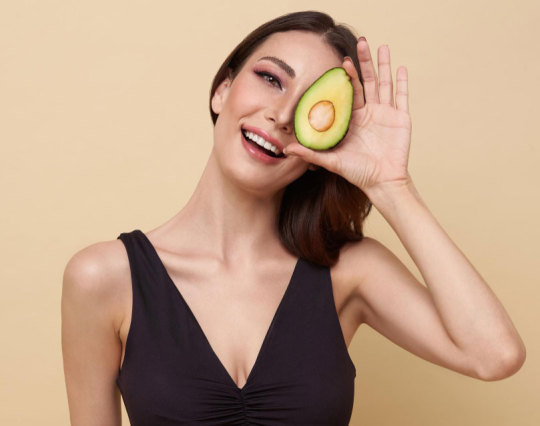
View On WordPress
#avocado#avocado benefits for skin#avocado fruit#avocado good for you#avocado health benefits#avocado ice cream#avocado oil benefits#avocado seed benefits#avocado toast#avocado topping#benefits of avocado#best avocado toast#david avocado wolfe#fresh avocado#fried avocado#fuerte avocado#hass avocado#persea#ripe avocado#smashed avocado#types of avocados#vitamins in avocado#what are the benefits of avocado?#What Are The Benefits Of Avocado?: Is Avocado Good For You#what are the benefits of drinking boiled avocado leaves?#what are the benefits of eating avocado?#what are the health benefits of avocado?#what does avocado do for you?#what does avocado do to your body?#what happens when you eat avocado everyday?
0 notes
Text
Unraveling the Essence of Advent Health
Introduction to Advent Health
In the ever-evolving landscape of healthcare, one institution stands out for its unwavering commitment to holistic well-being – Advent Health. This article delves into the multifaceted aspects of Advent Health, exploring its history, mission, services, and the impact it has on communities.
History and Background
Advent Health traces its roots back to a visionary…

View On WordPress
#Advent Health#athena health login#atrium health#avocado health benefits#celine dion health#chia seeds health benefits#cinnamon health benefits#Ellie Mental Health#ginger health benefits#health benefits#health benefits of apple cider vinegar#health benefits of chia seeds#health benefits of cinnamon#health benefits of ginger#mental health#mental health awareness#mental health counselor#sutter health#texas health benefits#united health care
0 notes
Text
When I prepare my own hair care. That is how I see myself.
Quand je prépare mes propres soins capillaires... voilà comment je me vois.

#natural#nature#natural hair#naturalhair#curly#curl#curls#natural curls#curlsfordays#handmade#haircare#cheveux#bouclé#avocado oil#shea butter#castor oil#black seed oil benefits#black seed oil uses#naturalproducts#homemade#naturalhairsistas#natural hairstyle#big hair#curly hair#naturalhairdaily#witchlife
1 note
·
View note
Text
holistic wellness series: cycle synching
🌱 what is cycle synching?
in short, cycle synching is coordinating your lifestyle habits with the phases of your menstrual cycle.
🌱 benefits of cycle synching
cycle synching can help you optimize energy levels and improve your understanding of your cycle, which, in turn, can boost estrogen levels and even boost fertility. it can also improve your hormone balance overall, which helps ease stress and period symptoms.
the menstrual phase (days ~1-5)
exercise: since the energy is low during this phase, focus on low-impact movement. this can include yoga, walking, and stretching.
food: focus on comforting and easily digested food. soups, decaf tea, veggies (lots of greens!), etc.
the follicular phase (days ~6-14)
exercise: in this phase, energy begins to rise again. great exercise options can include moderate weight lifting or cardio, jogging, swimming, and pilates.
food: light veggies and fruit and lean protein, such as eggs, salmon, poultry (like turkey), and cheese.
the ovulatory phase (days ~15-20)
exercise: energy is the highest in this phase, so high-intensity and sweaty workouts, such as hiit or vigorous weight training are optimal here.
food: lots of fiber and water to support digestion and healthy fats such as fish, nuts, and avocado.
the luteal phase (days ~20-28)
exercise: energy begins to decrease before the cycle repeats. focus on moderate exercise such as bodyweight strength training, pilates, more intense yoga, and cardio.
food: healthy fats and lots of fiber! veggies such as sweet potato and squash, seeds, salmon, and dark chocolate are good options for this time.
#health#women’s health#that girl#dream girl#it girl#self care#self love#glow up#becoming that girl#self help#self improvement#self development#health aesthetic#health and lifestyle#health is wealth#health blog#fitness#fitness blog#holistic health#holistic wellness#wellness#wellness girl#pink pilates princess aesthetic#pink pilates girl#pink pilates princess#green juice girl#green juice girl aesthetic#clean girl#clean girl aesthetic#femininity
2K notes
·
View notes
Text
Buy Uniqaya Vitamin C Foaming Face Wash for Skin Brightening

Restore the radiance of your skin, a day at a time!

Deep Cleansing Vitamin C Foaming Face Wash with Milk Thistle & Seaweed Lettuce, 100 ml
Buy Vitamin C Foaming Face Wash Online. Buy All skincare products online at affordable prices only in UNIQAYA.COM
#foaming face wash for oily skin#foaming face wash for acne#vitamin c foaming cleanser#best face wash for sensitive skin#brightening face wash for sensitive skin#chemical free face wash for sensitive skin#best face wash for dry skin#best face wash for oily skin#foaming face wash with milk thistle#foaming face wash with milk#avocado benefits for skin#vitamin c foaming face wash#carrot seed oil benefits#vitamin c face wash benefits#foaming face wash benefits#deep cleansing vitamin c foaming face wash#deep cleansing vitamin foaming face wash#face wash#foaming face wash#best foaming face wash#face wash for dry skin#online shopping for milk face wash#face wash for sensitive skin#best face wash#buy face wash for oily skin#buy face wash for dry skin#sunscreen#skincareproducts#uniqaya#uniqayalifestyle
0 notes
Text
Deep Cleansing Vitamin C Foaming Face Wash with Milk Thistle
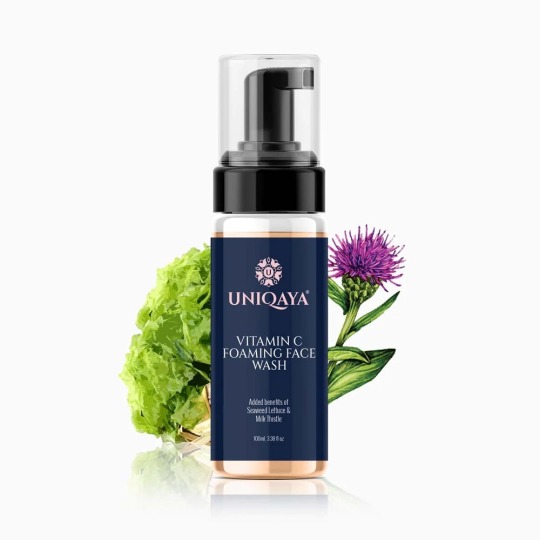
One of the few vitamins that humans cannot make in their bodies is vitamin C. It works directly on the collagen protein, which is naturally found in your skin, and aids in preventing wrinkling and sagging of the skin. The body's collagen production slows down with age. As a result, a vitamin C boost for the skin can promote the development of new collagen. This is the reason why it's a dermatologist's favorite ingredient as it works to reduce the appearance of fine lines and wrinkles, protect our skin from sun damage, and slow down the onset of early signs of aging.
We provide you the Uniqaya Deep Cleansing Vitamin C Foaming Face Wash with Milk Thistle & Seaweed Lettuce to get a powerful boost of vitamin c. It contains Kakadu plum-derived vitamin C, which repairs tissues and lightens scars while hydrating and nourishing skin for a youthful and radiant glow.
Uniqaya’s foaming facewash restores radiance, evens out wrinkles and ensures hydration. Order Uniqaya Deep Cleansing Vitamin C Foaming Face Wash with Milk Thistle & Seaweed Lettuce, 100 ml online at the best price in India.
#foaming face wash for oily skin#foaming face wash for acne#vitamin c foaming cleanser#best face wash for sensitive skin#brightening face wash for sensitive skin#chemical free face wash for sensitive skin#best face wash for dry skin#best face wash for oily skin#foaming face wash with milk thistle#foaming face wash with milk#avocado benefits for skin#vitamin c foaming face wash#carrot seed oil benefits#vitamin c face wash benefits#foaming face wash benefits#face wash#foaming face wash#best foaming face wash#face wash for dry skin#online shopping for milk face wash#face wash for sensitive skin#best face wash#buy face wash for oily skin#buy face wash for dry skin#hydrating moisturizer#moisturiser for dry skin#moisturiser for oily skin#hydrating moisturiser for dry skin#hydrating moisturizer for face#face moisturizer for dry skin
0 notes
Text
#carrots#health benefits#health benefits of fennel seeds#health benefits of pomegranate#health benefits of avocado oil#health benefits of cherries#health benefits of drink water in an empty stomach#healthy life#nutrition#metabolism#healthy#healthy lifestyle
0 notes
Text
Superfoods you should incorporate in your diet:
Superfoods are nutrient-dense foods that are considered beneficial for your health due to their high concentration of vitamins, minerals, antioxidants, and other beneficial compounds.
Combine these superfoods with a variety of other whole foods to ensure you're getting a wide range of nutrients. Also, be mindful of portion sizes and any individual dietary restrictions or allergies you may have.
Berries: Blueberries, strawberries, raspberries, and other berries are rich in antioxidants, fiber, and vitamins.
Leafy greens: Spinach, kale, Swiss chard, and other leafy greens are packed with vitamins, minerals, and fiber. They are low in calories and provide important nutrients like vitamin K, vitamin C, and folate.
Cruciferous vegetables: Broccoli, cauliflower, Brussels sprouts, and cabbage are part of the cruciferous vegetable family. They contain compounds that may help reduce the risk of certain cancers.
Nuts and seeds: Almonds, walnuts, chia seeds, flaxseeds, and hemp seeds are excellent sources of healthy fats, protein, fiber, and various vitamins and minerals.
Fish: Fatty fish like salmon, sardines, and mackerel are rich in omega-3 fatty acids, which are beneficial for heart health and brain function.
Whole grains: Quinoa, brown rice, oats, and whole wheat are examples of whole grains that provide fiber, vitamins, and minerals.
Legumes: Beans, lentils, chickpeas, and other legumes are high in fiber, protein, and various nutrients. They are also a good source of plant-based protein.
Turmeric: This spice contains curcumin, a compound with potent anti-inflammatory and antioxidant properties.
Green tea: Green tea is rich in antioxidants called catechins and is believed to have various health benefits, including improved brain function and a lower risk of certain diseases.
Dark chocolate: Dark chocolate with a high cocoa content (70% or higher) is a source of antioxidants and may have positive effects on heart health and mood.
Avocado: Avocados are rich in healthy fats, fiber, and various vitamins and minerals. They also provide a good source of potassium.
Greek yogurt: Greek yogurt is a protein-rich food that also contains beneficial probiotics, calcium, and vitamin B12.
Sweet potatoes: Sweet potatoes are packed with vitamins, minerals, and fiber. They are an excellent source of beta-carotene, which is converted into vitamin A in the body.
Garlic: Garlic contains sulfur compounds that have been associated with potential health benefits, including immune support and cardiovascular health.
Ginger: Ginger has anti-inflammatory properties and is commonly used to aid digestion and relieve nausea.
Seaweed: Seaweed, such as nori, kelp, and spirulina, is a rich source of minerals like iodine, as well as antioxidants and omega-3 fatty acids.
Pomegranate: Pomegranates are packed with antioxidants and are believed to have anti-inflammatory properties. They are also a good source of vitamin C and fiber.
Cacao: Raw cacao is the purest form of chocolate and is rich in antioxidants, flavonoids, and minerals. It can be enjoyed as nibs, powder, or in dark chocolate form.
Quinoa: Quinoa is a gluten-free grain that provides a complete source of protein, along with fiber, vitamins, and minerals.
Extra virgin olive oil: Olive oil is a healthy fat option, particularly extra virgin olive oil, which is high in monounsaturated fats and antioxidants.
Chia seeds: Chia seeds are a great source of fiber, omega-3 fatty acids, and antioxidants. They can be added to smoothies, yogurt, or used as an egg substitute in recipes.
Beets: Beets are rich in antioxidants and are known for their vibrant color. They also contain nitrates, which have been shown to have beneficial effects on blood pressure and exercise performance.
Matcha: Matcha is a powdered form of green tea and is known for its high concentration of antioxidants. It provides a calm energy boost and can be enjoyed as a tea or added to smoothies and baked goods.
Algae: Algae, such as spirulina and chlorella, are nutrient-dense foods that are rich in protein, vitamins, minerals, and antioxidants. They are often consumed in powdered or supplement form.
Fermented foods: Fermented foods like sauerkraut, kimchi, kefir, and kombucha are rich in beneficial probiotics that support gut health and digestion.
Maca: Maca is a root vegetable native to the Andes and is often consumed in powdered form. It is known for its potential hormone-balancing properties and is commonly used as an adaptogen.
Goji berries: Goji berries are small red berries that are rich in antioxidants, vitamins, and minerals. They can be enjoyed as a snack or added to smoothies and oatmeal.
Hemp seeds: Hemp seeds are a great source of plant-based protein, healthy fats, and minerals like magnesium and iron. They can be sprinkled on salads, yogurt, or blended into smoothies.
Moringa: Moringa is a nutrient-dense plant that is rich in vitamins, minerals, and antioxidants. It is often consumed as a powder or used in tea.
Mushrooms: Certain mushrooms, such as shiitake, reishi, and maitake, have immune-boosting properties and are rich in antioxidants. They can be cooked and added to various dishes.
#health tips#healthy lifestyle#health and wellness#nutrients#healthy life tips#healthy life hacks#healthy diet#level up journey#high value mindset#health is wealth#levelupjourney#glow up tips#glow up#nutrition#healthy living
2K notes
·
View notes
Note
How to stop overeating while on your period because I have a good week but as soon as it’s my period I crave sugary sweet foods and just oily foods
this happen to me during my period. if your body is asking you to eat more, go for it, but with healthy choices and foods that help you feel good during your period.
some examples:
pineapple
nuts
carrot
fish
watermelon
eggs
banana
dark chocolate
and also tea: cinnamon, ginger, turmeric or rosemary
my favourite for these days is ginger.
and you can make something filling and nutritious with some of these foods. i would say:
toast with avocado and a fried egg or smoked salmon, add chia seeds on top for example.
a fruit salad with the aforementioned fruits.
a bowl with greek yoghurt, banana, oatmeal and dark chocolate.
you can also opt for a baked fish and a vegetable side dish.
and if you're hungry between meals, nuts and dried fruit are filling and have many benefits.
the point is not to stop eating but to learn to eat well and what your body is asking for. a nutritious meal will always fill you up and you won't need sugary or oily food.
and if you feel like eating "junk food" for a day, there is nothing wrong with that. it is positive to find a balance.
and remember to take care of yourself during your period days.
remember that i am not a specialist in this, it is what i usually eat and researched that it is good.
#that girl#green juice girl#self love#self esteem#levelup#self improvement#self worth#leveling up#pink pilates princess#level up journey#mindset#healthy tips#health tips#healthy weight loss#glow up#self growth#self confidence#self development#self care#period cramps#healthy#healing#healthy diet#healthy living
294 notes
·
View notes
Note
I work in a whole foods supply store, and one of our customers is a lovely old lady who lives out on a rural property, way beyond the city limits.
A pair of peacocks have nested and made babies at the edge of her land (two clutches so far this year), and she has taken it upon herself to feed them, so she comes to us to buy food - seeds, chopped nuts and dried fruits.
I know she means well, but she says the babies now come to her door to 'beg' for food, which means they're habituating, so I feel like she's doing them more harm than good.
If you knew of someone doing this, would you leave them to it, or try to dissuade them? Also, is the food I described above actually okay for peacocks?
She says the peahen is a bright, beautiful, unblemished white, which I thought was quite rare? She is going to bring me photos on her next visit...
Unless you're in India, they're not habituating because they're not wild animals, they're feral domestics. If they're hanging around and being fed, congrats, she's got free range peafowl. It's free birds!
As for the mix, I would cut out the nuts. Fruits are fine but they don't really like citrus and they shouldn't have avocado. Fresh fruits are better than dried, dried concentrates the sugars and doesn't provide any hydration. If she'll listen to you, tell her you have a friend that breeds peafowl and that they suggested better treats would be live mealworms or superworms, dubia roaches, farm-raised hornworms, or mouse pinkies. They also like fish (at least feeder fish, but possibly also larger fish they can pick apart) and meats. They can be given veggies, but they don't rip things apart the way chickens do their beaks are not as able to tear into hard things, so veggies should be chopped small. They will happily rip up greens or melons that are cut open though. Banana too! They love banana and berries.
Black oil sunflower seed and safflower are good seeds, limit corn intake. No beans allowed except refried ones. Planting clover in her yard will be a good source of nutrient-rich greens (and good for bees!).
But honestly, a good high-protein dry chow with some water added fresh to it will provide a lot of benefit, just as much attention, and probably be cheaper since you can get 50lb for like $20. I use Belstra 28% turkey starter crumble from a local feed mill. It may not look as interesting but my birds get a LOT of varied treats and chow mash is one they'll eat every day without any hesitation, and leave nothing behind. The only other treats that is true for are bugs and farmer's helper golden egg nugget treats. Even peanuts they have turned their noses up at a couple of times.
As for the white color, it's not that rare. A lot of people don't like to keep them because they get dirty easily and because colored birds often HATE them. Hens often won't mate with them if they can see other males, and males often attack or attempt to chase off white hens. In the wild, a white animal draws attention and opens the flock to predation.
110 notes
·
View notes
Note
tips on how to change to a better person and be a new person both physically and mentally. i want to transform into a new person within a few months but don’t know how or where to start
Hi love! While everyone's lifestyles and goals are different, here are some general tips that can only make your quality of life better:
Eat A Predominately Whole Foods, Plant-Based Diet: Unprocessed non-animal foods like fruits and vegetables, whole grains, plant proteins (peas, beans, edamame, etc.), nuts and seeds, root vegetables, and healthy whole fats (like avocado) should make up around 80% of your diet. Stick to water, black coffee, and tea either plain or with lemon, too to avoid unnecessary sugars.
Get In Your Steps & Gentle Movement: Try to average around 7-10K steps a day to feel the benefits of walking. Incorporate a light strength training exercise (pilates, yoga, a YouTube body weight or free weight workout, etc.) into your routine 2-3 times a week for around 15 minutes each.
Read Daily: Commit to 10 pages of book reading and 30 minutes of article reading at different times of the day to learn, stay updated on the world and strengthen your cognitive function/ability to focus.
Take Time To Self-Reflect: Journal for at least 10 minutes a day. Either practice morning pages (free writing 3 pages in the morning) or choose a prompt or two from a therapist, shadow work journal, and a blog post. See my latest Femme Fatale journal prompts to reset for 2023 in this private membership post.
Carefully Curate Your Circle of Influence: Be mindful of who you spend time with, what topics you discuss, and what information you share with each of these members of your inner circle. You're always allowed to set boundaries around who you want to speak to outside of work (and children who are minors, of course, if you have them) and what information you want to disclose with them. Protect your peace at all costs.
Set Intentional Goals: Create well-defined goals with a clear action plan in the major areas of life (career, finances, health, relationships, personal development). Consistency, not intensity, is essential for goal achievement. So, make sure to do little tasks each day or week to ultimately achieve your desired results.
Keep Track of Your Tasks: Have a to-do list for professional tasks, items to buy for the house, errands to do, grocery lists, appointments to schedule, bill due dates, invoicing timelines, etc. Keep track of these items on your Notes App, Reminders, or within Google Calendar/Keep – depending on how time-sensitive a task might be.
Make Time For Self-Care: Block out an hour or so of your day to purely focus on yourself. This ritual can include your daily non-negotiables like a shower, skincare, reading, journaling, etc., and can include other indulgent activities like a face mask, exfoliating, doing your nails, watching your favorite TV show, etc. Prioritize yourself.
Create An "I Love" List: Stealing this tip from Jessica Garner (sex educator on TikTok) because I love it so much. Whenever you find an activity, meal, experience, song, item of clothing, etc, add it to your "I Love" list (on your notes app, etc.) to remind yourself of the things in life that bring you joy. This list can serve as a source of inspiration when you're feeling down and give you a built-in list of ideas to lift your spirits in some type of way on your more depressing or stressful days.
See the rest of my best habit ideas to implement for 2023 HERE.
Hope this helps xx
#femme fatale#dark feminine energy#dark femininity#it girl#dream girl#queen energy#high value woman#high value mindset#higher self#self concept#self care#healthyhabits#loa#level up#glow up#the feminine urge#female power#female excellence#femmefatalevibe
368 notes
·
View notes
Text
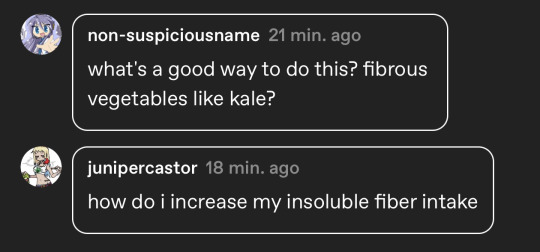
@non-suspiciousname @junipercastor i’m not a dietician or doctor disclaimer disclaimer if you have preexisting conditions this may not be for you disclaimer disclaimer i cannot account for every human experience disclaimer disclaimer BUT the easiest way to do this is to first learn what “high fiber foods” means.
and before i begin, here’s how much fiber we more or less need via a helpful Harvard health article.

so, to recap: for women—the ones who matter to me—that’s 25g for adult women who are 50 and under. women 50 and over, that’s 21g.
and i included the extra paragraph about Metamucil etc bc that is important to note. a lot of people do think they’re getting quality daily fiber in these powders.
here’s a helpful article abt the differences between soluble and insoluble fiber. both are important in their own ways!
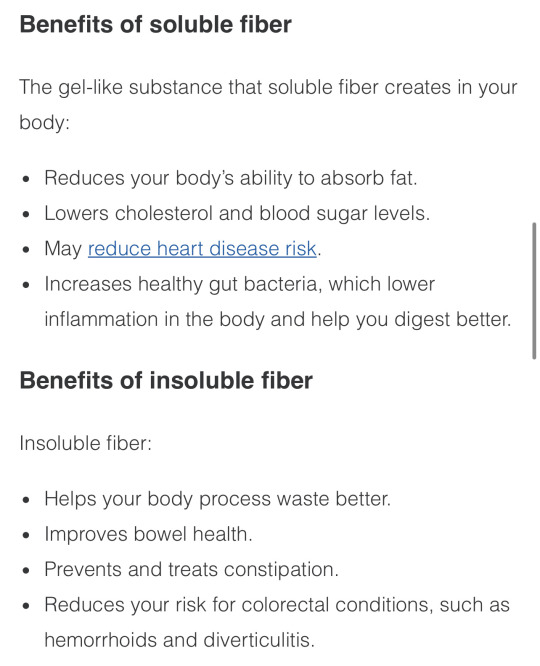
and just so we’re clear on the benefits of upping your fiber intake:
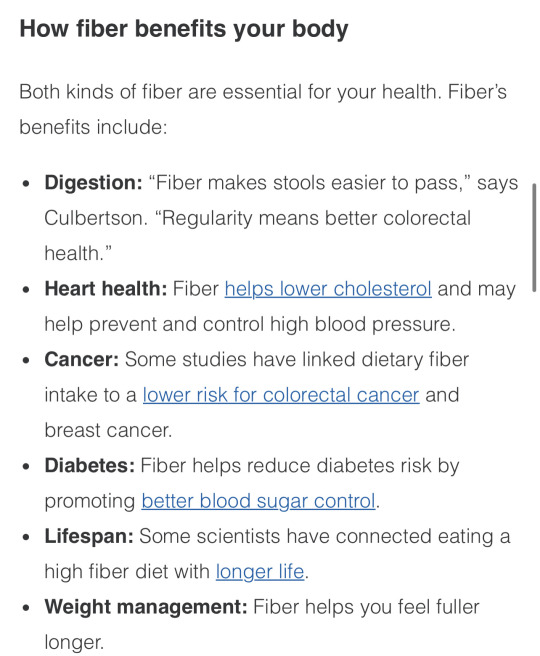
so!
i recommend a quick google to see the fiber content per serving of a variety of foods that i don’t have time condense here. but, like, beans are a really inexpensive way to do this (add some rice to it and you have a complete muscle-lovin’ protein btw! all the essential amino acids are covered when you combine rice and beans 🫶). beans and legumes are incredibly rich in fiber, and they’re budget-friendly, shelf-stable, and easy to make and easy to incorporate into infinite delicious possible dishes.
but your fiber can be gotten from so many different sources! (my data here is approximate from individual checking. pls allow 1-2g of fiber for margin of error in case i mistype!)
for fruits: 1 cup of blackberries OR raspberries has 8g of fiber!!!!! 1 medium apple has around 4-5g of fiber. an average banana or a serving of strawberries have 3g of fiber. an average avocado has 10g of fiber. and so forth
for grains: steel-cut oats have 5g of fiber per 1/4 cup uncooked (oats are generally rich in fiber anyway, but steel cut in particular). a slice of whole grain bread should have around 3g fiber. brown rice contains 3.5g fiber for every cooked cup. one cup of cooked quinoa (which is also a complete protein!) contains 5g of fiber. bran is almost 15g per one cup serving.
if you’ve got access to chia seeds, a 1oz serving provides 10g fiber. here’s a yummy super easy recipe for peanut butter chia pudding!!!
nuts and seeds provide a lot of fiber too. 1oz of walnuts contains nearly 2g fiber! 1oz of almonds contains 3.5g fiber. peanuts contain 2.5g fiber for 1oz. sunflower seeds are 12g per 1 cup serving (though that’s a lot of them to eat—1/4 a cup would be closer to 3g)
and my fave prunes are 12g per one cup serving. again, that’s a lot of them to eat. 1/4 of that would be 3g.
beans/legumes are king for fiber. 1 cup of cooked black beans contains 15g of fiber. 1 cup of navy beans contains around 19g of fiber. 1 cup of kidney beans contains 11g of fiber.
split peas are i think around 8g per cup when cooked? cooked broccoli is around 5g. corn is around 4g.
i could go on but i’m literally hooked up to an IV for medication rn so i’m one-handed lol i apologize for how cramped this is
but here’s a great list from the Mayo Clinic of high fiber foods and another list of 40 foods from a women’s health mag and also another from healthline, which also has a handy chart for fiber requirements for more specific age groups based on sex
and yes, there are also high-fiber cereals, but beware of the much-touted and rightly-feared ingredient of psyllium husk. it’s more or less used as a laxative and can be outright dangerous for your digestive system and is very painful if not consumed in militant moderation. ask me how i know lol. please please be careful of psyllium husk. like, for real. just stay away from it altogether imo.
sorry this is a lot of discombobulated info, but again i’m one handed at the moment. but hopefully that helps a bit! fiber is linked to longevity and good colon health and that’s what i want for women forever
EDIT: go slow with this! if you’re not used to the recommended daily intake, you will need to gradually work up to this so as not to upset your gastrointestinal system. you may otherwise find yourself in discomfort. GO SLOW. add fiber-rich foods in small portions over time to allow your body to adjust. it is well worth the patience—but don’t overload your system by eating a ton of prunes and thinking you’re doing yourself any good that way. introduce gently and in moderation until you feel comfortable with how it makes your digestion feel!
107 notes
·
View notes
Text
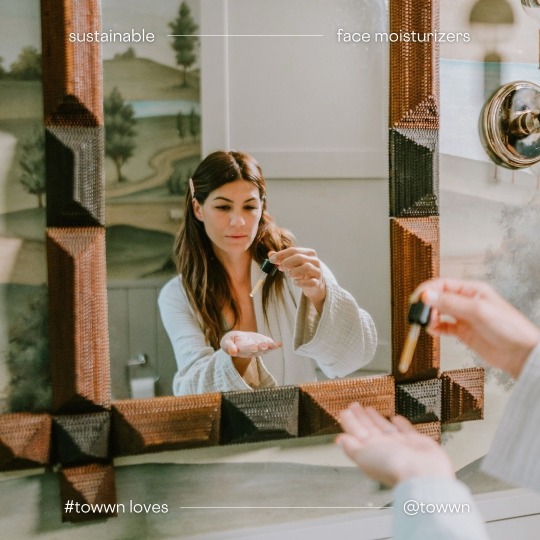
towwn: spring may have officially sprung, but that doesn’t mean the weather *or your skin* are ready to cooperate. transition months can be tricky on your complexion so we rounded up some of our favorite eco face moisturizers for every skin type + need that won’t weigh you down as the temperatures climb up. the best part? the daily moisturizers listed here all embrace organic, clean + ethical sources while avoiding harsh chemicals that are bad for you + the planet. time to let the sunshine in – don’t forget the spf!
@kosas
this hydrating tinted gel cream is made with copper peptides + developed with plant-based ingredients. two key ones: sugarcane-derived squalane + salicornia herbacea, a saltwater succulent, which help to plump + smooth.
@opulusbeautylabs
a daily for problem skin, this lightweight brightening formula contains vitamin c+ derived from citrus fruits. the brand uses no plastics and wraps items in recyclable paper only.
@ireneforte
a b-corp certified leader in social + eco-responsibility, the brand’s cream stands out as a plant-based daily. it contains anti-aging myoxinol, a unique derivative of hibiscus seeds, plus olive oil, rice protein + the namesake prickly pear, lending hydration to dry or mature skin.
@versed
this best-selling gel rings in at under $20. crafted with high-quality, cruelty-free ingredients like green tea extract + aloe leaf juice that protect skin from free radicals + inflammation.
@sixgldn
with a blend of botanicals + plant stem cell tech, this light oil-based serum is ultra nourishing while protecting against environmental stress + boasting anti-aging benefits.
@tataharperskincare
sustainably handcrafted on a vt farm, this lightweight hydrator targets roughness, dryness + dullness.
@biossance
this gel offers deep daily hydration with probiotics + plant sterols to soothes reactive skin while replenishing the microbiome.
@goodmolecules
a lightweight daily with nourishing avocado oil + shea butter. it’s suitable for all skin types + effectively smooths and preps your face for makeup.
16 notes
·
View notes
Text
Top 10 Healthy Foods for Your Diet
In a world inundated with fad diets and conflicting nutritional advice, finding the right foods to fuel your body can feel like navigating a maze. But fear not! We've compiled a list of the top 10 healthy foods that will not only nourish your body but also tantalize your taste buds. Say goodbye to confusion and hello to delicious, nutritious eating!

Avocados
Avocados are not only delicious but also incredibly nutritious due to their high content of heart-healthy monounsaturated fats, fiber, potassium, and vitamins C, E, and K. They can be enjoyed in various ways, such as smashed on toast, whipped into guacamole, or sliced onto salads, making them a versatile addition to any meal.
Berries
Berries, including strawberries, blueberries, raspberries, and blackberries, are not only nature's sweet treat but also packed with antioxidants, vitamins, and fiber. Adding berries to your diet can have various health benefits, including boosting brain health, supporting heart health, and aiding in weight management. They can be enjoyed fresh, frozen, or blended into smoothies for a refreshing burst of goodness.
Leafy Greens
Leafy greens like spinach, kale, Swiss chard, and arugula are nutrient-dense and offer a myriad of health benefits due to their high content of vitamins, minerals, and antioxidants. These benefits include improved digestion, enhanced immunity, and reduced risk of chronic diseases like heart disease and diabetes. Leafy greens can be incorporated into your diet by tossing them into salads, sautéing with garlic, or blending into green smoothies.
Salmon
Salmon is a nutritional powerhouse rich in omega-3 fatty acids, protein, and vitamin D, making it beneficial for heart health and brain function. It also has anti-inflammatory properties that can help reduce the risk of chronic diseases. Salmon can be enjoyed grilled, baked, or broiled, offering a delicious way to reap its numerous health benefits.
Nuts and Seeds
Nuts and seeds, including almonds, walnuts, chia seeds, and flaxseeds, are rich in healthy fats, protein, fiber, vitamins, and minerals, making them a nutritious snack. Snacking on nuts and seeds can help curb hunger, stabilize blood sugar levels, and promote heart health. They can be sprinkled on salads, added to oatmeal, or enjoyed straight out of the bag for a satisfying and nutritious snack.
Whole Grains
Whole grains like quinoa, brown rice, oats, and barley are packed with fiber, vitamins, minerals, and antioxidants, providing sustained energy and supporting digestive health. They can also help lower cholesterol levels and are a smart choice for overall health whether as a side dish, in soups and stews, or as a breakfast staple.
Greek Yogurt
Greek yogurt is rich in probiotics, calcium, and B vitamins, making it excellent for gut health and bone health. It can be enjoyed plain or mixed with fruit and honey for a sweet treat, and is a versatile ingredient that belongs in every healthy diet, whether as a breakfast staple, a creamy topping for tacos, or a base for creamy dressings.
Beans and Legumes
Beans and legumes like black beans, chickpeas, lentils, or kidney beans are loaded with protein, fiber, vitamins, and minerals, making them perfect for soups, salads, stews, and dips. Incorporating them into your diet can help promote satiety, stabilize blood sugar levels, and support digestive health.
Sweet Potatoes
Sweet potatoes are packed with fiber, vitamins, and antioxidants, particularly rich in beta-carotene, which is essential for eye health, immune function, and skin health. Whether roasted, mashed, or baked, sweet potatoes are a tasty and nutritious addition to any meal.
Broccoli
Broccoli is packed with vitamins, minerals, and antioxidants, offering a myriad of health benefits, including immune support, heart health, and cancer prevention. Whether steamed, roasted, or sautéed, incorporating broccoli into your diet is an easy way to boost your nutrient intake and support overall health.
Discover the best morning routine for a healthier lifestyle and kickstart your day with our expert tips.
#thewizardliz#the wizard liz#wonyoungism#morning routine#study routine#workout routine#shower routine#self care routine#night routine#aesthetic#coquette#dream girl#it girl#pink blog#that girl#pinterest#pink pilates princess#glow up#beauty tips#girly#pinterest girl#becoming that girl#pink princess#productivity#motivation#inspo#self care#dream life#mindset#affirmations
12 notes
·
View notes
Text
The best part of Hanukkah? No question: All the delicious fried foods we eat, which commemorates the oil lasting eight nights instead of just one. If you are gearing up for some latke, donut, churro or bumuelo frying, here are some of the best oils to handle the job.
Canola or Vegetable Oil
My go-to oil for frying latkes – or anything that takes a bit of time to fry (like schnitzel or sufganiyot) – is canola or vegetable oil because of its high smoke point and neutral flavor. When you are frying you tend to use a larger quantity of oil, and it’s definitely the most cost-effective choice. You can reuse canola oil for frying – just use a fine mesh sieve to strain out any pieces of food in the oil, store in a container at room temperature, and use 1-2 additional times, depending on how much cooking debris is left in the oil.
Safflower Oil
Made from sunflower seeds, safflower oil has a high smoke point and neutral flavor, but is pricier than canola or vegetable oil. However, it may be the healthier option for frying, since some research has indicated that there are numerous health benefits to cooking with it, including fighting inflammation and boosting heart health.
Avocado Oil
Like safflower oil, avocado oil has a high smoke, though it has a much stronger – sometimes sweet – flavor, which may add an unwanted taste, especially when it comes to latkes. It also can be pricey, and since you need a large quantity of oil for Hanukkah-frying projects, that can add up quickly.
Peanut Oil
Peanut oil has a high smoke point, which is why it’s commonly used for deep frying (hello, Five Guys French fries!). It can add a rich, nutty or buttery flavor, which you may or may not enjoy. While it’s a cheaper option than safflower oil and avocado oil, due to the prevalence of nut allergies, I tend to stay away from using this, just in case.
Schmaltz
OK, I wouldn’t recommended frying your latkes exclusively in schmaltz for two reasons: it’s pretty fatty and you will need a large quantity of it. However, if you are into going old-school, my recommendation is to use ⅔ canola oil to ⅓ schmaltz, to balance the flavor.
7 notes
·
View notes
Text
Buy Skin Balancing Moisturiser & Foaming Face Wash Online
Buy #Uniqaya’s #Skin #Balancing #Moisturiser & #Vitamin C #Foaming #Face #Wash #online at the Best Price.
Uniqaya’s foaming face wash restores radiance, evens out wrinkles and ensures hydration & Moisturiser Improve the hydration level of your face with moisture-lock technology.
#foaming face wash for oily skin#foaming face wash for acne#vitamin c foaming cleanser#best face wash for sensitive skin#brightening face wash for sensitive skin#chemical free face wash for sensitive skin#best face wash for dry skin#best face wash for oily skin#foaming face wash with milk thistle#foaming face wash with milk#avocado benefits for skin#vitamin c foaming face wash#carrot seed oil benefits#vitamin c face wash benefits#foaming face wash benefits#deep cleansing vitamin c foaming face wash#face wash#foaming face wash#best foaming face wash#face wash for dry skin#online shopping for milk face wash#face wash for sensitive skin#best face wash#buy face wash for oily skin#buy face wash for dry skin#best ultra moisturizer for glowing skin#hydrating moisturizer for sensitive skin#best moisturizer for glowing skin#hydrating moisturiser for oily skin#best cream for sensitive skin
0 notes